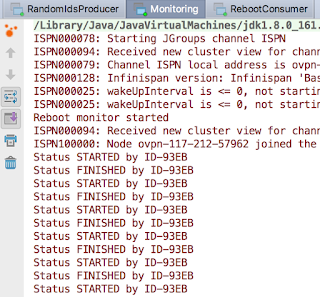We have recently released
infinispan-spring-boot-starter 2.0.0.Final. This version supports
Spring Boot 2.1 and
Infinispan 9.4.0.Final.
Before this release, some important features - such as near caching - were only configurable by code.
From now on, we can set all of the Hot Rod client configuration using the
hotrod.properties file or the
Spring application YAML. The latter is an important community requirement we had.
Let's see how to speed up our applications performance with
near caching!
Hot Rod
Just as a quick reminder, Infinispan can be used embedded in your application or in
client/server mode. To connect you application to a server you can use an
Infinispan Client and the Infinispan
“Hot Rod Protocol”. Other protocols are available, such as REST, but Hot Rod is the most recommended way since it is the one that supports most of the Infinispan functionalities.
Near cache
From the Infinispan
documentation:
Hot Rod client can keep a local cache that stores recently used data. Enabling near caching can significantly improve the performance of read operations
get and
getVersioned since data can potentially be located locally within the Hot Rod client instead of having to go remote.
When should I use it?
Near caching can improve the performance of an application when most of the accesses to a given cache are read-only and the accessed dataset is relatively small.
When an application is doing lots of writes to a cache, invalidations, evictions and updates to the near cache need to happen. In this scenario we won't probably get much benefit.
As I said in the introduction, the good news is that
this feature can be activated just by configuration. Code doesn't change, so we can measure the benefits, if such exist, in a very straightforward way.
Spring-Boot
I have created a very simple application, available
here. Maven, Java 8 and an Infinispan server are required to run it. You can
download the server or use
docker.
Docker: docker run -it -p 11222:11222 jboss/infinispan-server:9.4.0.Final
Standalone: PATH/infinispan-server-9.4.0.Final/bin/standalone.sh
Once the server is up and running, build the application using maven
>> infinispan-near-cache: mvn clean install
Writer
This application loads the required data to a remote cache: a list of some of the Infinispan contributors over the last decade.
>> writer: mvn spring-boot:run
Reader
The reader application does 10.000 accesses to the contributors cache. Using a random id, I call 10.000 times the
get method. The job gets done in my laptop in ~4000 milliseconds.
>> reader-no-near-cache: mvn spring-boot:run
Activating the near cache
I need to configure two properties:
- Near Cache Mode: DISABLED or INVALIDATED. Default value is DISABLED, so I turn it on with INVALIDATED.
- Max Entries: Integer value that sets the max size of the near caches. There is no default value, so I set up one.
The hotrod client configuration is
for each client,
not for each cache (this might change in the future). With that in mind, note that configuring the previous properties will activate near caching
for all the caches. If you need to activate it just for
some of them, add the following property:
- Cache Name Pattern: String pattern. For example "i8n-.*" will activate the near caching for all the caches whose name starts by "i8n-".
Configuration can be placed in the
hotrod-client.properties,
Spring-boot configuration or
code.
hotrod-client.properties
infinispan.client.hotrod.near_cache.mode=INVALIDATED
infinispan.client.hotrod.near_cache.max_entries=40
infinispan.client.hotrod.near_cache.cache_name_pattern=i8n-.*
application.yaml (or properties)
infinispan:
remote:
near-cache-mode: INVALIDATED
near-cache-max-entries: 10
near-cache-cache-name-pattern: i8n-.*
code
With the Infinispan Spring-Boot Starter, I can add custom configuration using the
InfinispanRemoteCacheCustomizer.
Results
My dataset contains 25 contributors. If I activate the near cache with max 12 entries and I run my reader again, I get the job done in ~1900 milliseconds, which is already an improvement. If I configure it to hold the complete dataset, I get it done in ~220 milliseconds, which is a big one!
Conclusions
Near caching can help us speed up our client applications if configured properly. We can test our tuning easily because we only need to add some configuration to the client. Finally, the
Spring-Boot Infinispan Starter helps us build services with Spring-Boot and Infinispan.
Further work will be done to help Spring-Boot users work with Infinispan, so stay tuned! Any feedback on the starter or any requirement from the community is more that welcome. Find us in
Zulip Chat for direct contact or post your questions in
StackOverflow!










